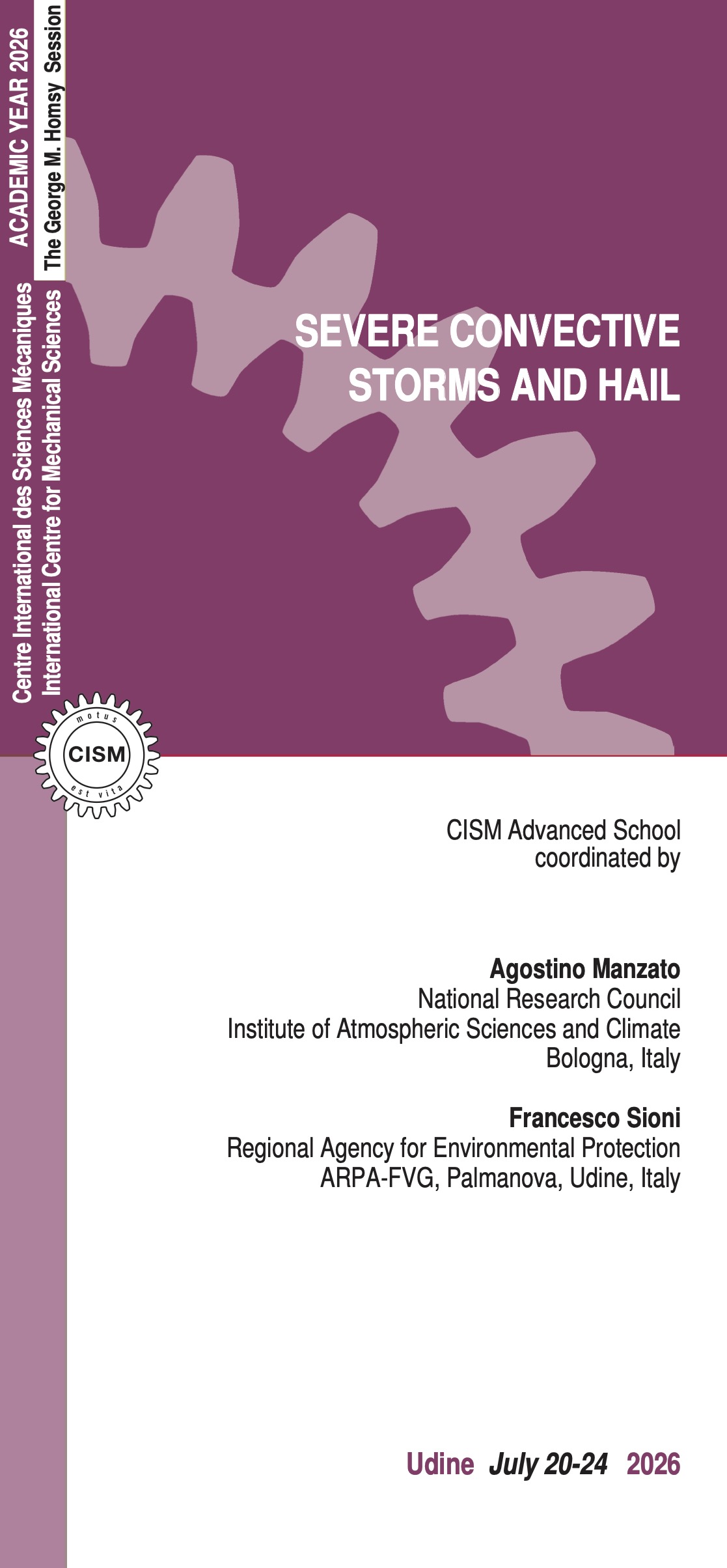Atmospheric convection drives many meteorological phenomena that pose significant threats to people and property. This course aims to provide participants with a robust and integrated understanding of convective storms, blending theoretical foundations with practical forecasting techniques, with a particular focus on hailstorms.
The program will begin with an overview of moist atmospheric thermodynamics. A key tool in this analysis are the radiosoundings and the respective thermodynamic diagrams, which will be explained to help participants develop a solid understanding of their interpretation. Among the most important outputs derived from radiosoundings are the instability indices; the course will delve into their climatology, emphasizing their spatial and temporal variability across complex terrain and different global regions.
The course will then transition into the dynamic aspects of convection. Different convective modes will be examined, each with its typical life cycle and associated hazards. Particular attention will be given to how complex terrain influences the evolution of convective systems. Real case studies and idealized model simulations will highlight how orographic features and sea-atmosphere interactions influence storm development and maintenance. Another key focus of the course will be the initiation of convection, exploring various triggering mechanisms such as bores, gravity waves, cold pools, and upslope flows along mountainous terrain.
Hailstorms, as one of the most damaging convective weather phenomena, can cause extensive damage to buildings, crops, and vehicles. The course will thoroughly examine hail microphysics, covering the processes of formation, growth, and melting, integrating theoretical knowledge with practical applications. Participants will gain insights into hail measurement and detection focusing on remote sensing techniques. The principles of radar operation will be discussed in detail, especially with regard to dual-polarization. A dedicated part of the course will deal with the ground-impacts from hailstorms and especially with the evaluation of hazards. The hail risk will be assessed through probabilistic models which also have insurance applications.
In addition to hail, other convective phenomena such as tornadoes, lightning and heavy convective rainfall will also be examined. This analysis will be conducted using a combined approach that integrates observational data with numerical modeling simulations. Daily weather briefings will provide an operational forecasting component, enabling participants to apply their knowledge to real-time convective scenarios. Finally, the potential impact of global warming on convective weather will also be addressed, taking into account both emerging observational trends and projections from numerical models.
The course is intended for graduate and PhD students, post-doctoral and senior researchers, operational weather forecasters and anyone interested in deepening their knowledge of deep atmospheric convection over mid-latitudes.
Allen, J. T. et al. (2020). Understanding hail in the earth system. Reviews of Geophysics, 58(1), e2019RG000665.
Kumjian, M.R.,et al. (2024). Radar and hail: Advances in scattering, detection, and sizing. In Precipitation Science, Scattering and Processing Algorithms Vol. 2. Institution of Engineering and Technology.
Kumjian, M. R., & Lombardo, K. (2020). A hail growth trajectory model for exploring the environmental controls on hail size: Model physics and idealized tests. Journal of the Atmospheric Sciences, 77(8).
Taszarek, M., Brooks, H. E., & Czernecki, B. (2017). Sounding-derived parameters associated with convective hazards in Europe. Monthly Weather Review, 145(4).
Kunz, M., et al. (2020). Ambient conditions prevailing during hail events in central Europe. Natural Hazards and Earth System Sciences, 20(6).
Lombardo, K., & Kading, T. (2018). The behavior of squall lines in horizontally heterogeneous coastal environments. Journal of the Atmospheric Sciences, 75(4).
Wu, F., and K. Lombardo (2021). Precipitation Enhancement in Squall Lines Moving over Mountainous Coastal Regions. Journal of the Atmospheric Sciences, 78.
Manzato, A., Riva, V., Tiesi, A., & Marcello Miglietta, M. (2020). Observational analysis and simulations of a severe hailstorm in northeastern Italy. Quarterly Journal of the Royal Meteorological Society, 146(732).
Raupach, T. H., et al. (2021). The effects of climate change on hailstorms. Nature reviews earth & environment, 2(3).
Pilguj, N.,et al. (2022). Are trends in convective parameters over the United States and Europe consistent between reanalyses and observations?. Journal of Climate, 35(12).
Manzato, A., et al. (2025). Relationships between Environmental Parameters and Storm Observations in Po Valley: Are They Climate Change Invariant?. Journal of Applied Meteorology and Climatology, 64(3).
6 lectures on:
Hail microphysics (energetics, kinetics, hail formation and growth); Hailstone melting and aerodynamic behaviors; Introduction to dual-polarization radar variables with applications in convective storms; Future of hail detection and quantification.
6 lectures on:
Hailstorm damage patterns across Europe and meteorological drivers: link between hail occurrence and atmospheric conditions; Large-scale hazard mapping from single events; Modeling hail risk for insurance applications; Hail hazard in a changing climate.
6 lectures on:
Gravity waves and bores in convection initiation, organization, evolution and maintenance (coastal and nocturnal convection); Impact of mountains on the evolution of organized convection traversing the terrain (cold pools, upstream and downstream environments).
4 lectures on:
Introduction to thermodynamics of moist air and pseudo-adiabatic lifting; Atmospheric profiling with radiosoundings and their thermodynamic diagrams; Climatology of cloud-to-ground lightnings, hail and rain in northeastern Italy.
4 lectures on:
Precursors of tornadoes in Mediterranean region; Case studies of hailstorms over northeastern Italy; Conceptual models for intense orographic precipitation in the Mediterranean region; Environmental conditions favorable to Mediterranean tropical-like cyclones.
1.5 hour lecture split into 5 weather briefings of 15 minutes each:
focused on real-time forecasting of convective phenomena;
1.5 lecture on: case studies of giant hail in north-eastern Italy with emphasis on operational forecasting decisions.
5 lectures on:
Skew-T and hodograph charts; Convective parameters and their climatology; Convective environments associated with severe storms in the world and their future evolution with global warming; Convective modes with associated hazards.
ADMISSION AND ACCOMMODATION
The course is offered in a hybrid format, allowing participants the flexibility to attend either in person or remotely via the Microsoft Teams platform. Admission to on-site attendance is granted on a first-come, first-served basis to comply with the capacity of the lecture room.
Registration fees:
- Early Bird On-Site Participation: € 650.00 + VAT* - Deadline: May 20, 2026
- Late On-Site Participation: € 800.00 + VAT* - Deadline: July 8, 2026
- Live Streaming Online Participation: € 250.00 + VAT* - Deadline: July 8, 2026
On-site participation includes a complimentary bag, five fixed menu buffet lunches, hot beverages, downloadable lecture notes.
Online participation includes downloadable lecture notes.
Application forms should be submitted online through the website: http://www.cism.it. A confirmation message will be sent to participants whose applications are accepted.
Upon request, and subject to availability, a limited number of on-site participants can be accommodated at the CISM Guest House for € 35 per person per night. To request accommodation, please contact foresteria@cism.it.
CANCELLATION POLICY
Applicants may cancel their registration and receive a full refund by notifying the CISM Secretariat in writing (via email) no later than:
- May 20, 2026, for early bird on-site participation;
- June 20, 2026, for late on-site participation;
- July 8, 2026, for online participation.
No refunds after the deadlines. Cancellation requests received before these deadlines and incorrect payments will be subject to a € 50.00 handling fee.
GRANTS
A limited number of participants from universities and research centers who do not receive support from their institutions can request a waiver of the registration fee and/or free lodging.
Requests should be submitted by email to the CISM Secretariat at info@cism.it by May 20, 2026. Submissions must include the applicant’s curriculum vitae and a letter of recommendation from the head of the department or a supervisor, confirming that the institute is unable to provide funding. Preference will be given to applicants from countries that sponsor CISM.





